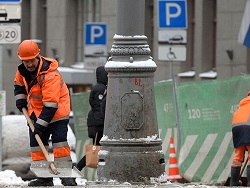Edward Epstein
 National Geographic
National Geographic
Russian archaeologists studying this summer, one of the northernmost Neanderthal sites in Europe, which is located near the city of Bryansk. The Department of science “Газеты.Ru” managed to talk to the leader of the expedition, candidate of historical Sciences, researcher of the Palaeolithic section of the Institute of history of material culture of RAS Alexander Next and find out how excavations are locals, does the Paleolithic black diggers and how can we learn to make tools of Neanderthal technology.
— For a long time you head Verkhnetumninsky the expedition and carry out excavations there. Is there some feature of the Parking Khotylevo I and were you able to detect traces of Neanderthals, who lived in this area?
Archaeological site Khotylevo I opened in the late 1950-ies by the archaeologist from the Bryansk Museum of Fyodor Mikhailovich by Zavernyaeva who excavated the separate parts from 1960 to 1964. Even then, it was found that one of Europe’s largest locations of the middle Paleolithic. Our expedition is studying Khotylevo I 2010.
Today we know of nine cultural layers found at different sites, and they all belong to the middle Paleolithic period, which is identified with Neanderthal man.
 Photo: Expedition Of Alexander Next
Photo: Expedition Of Alexander Next
So I Khotylevo this is not a Parking lot, and the complex multi-temporal middle Paleolithic sites. Now is the name for Khotylevo I more than adequately. Until we discovered the remains of the Neanderthal man in any of the cultural layers. But we hope that sooner or later such findings, we will. The discovery of fragments of human skeletons in the cultural layers of the monuments of lower and middle Paleolithic is such a rarity that each of these findings becomes sensational.
The main findings of the Neanderthal man in our country was done in the Crimea, the Caucasus and Altai. This cave monuments which are very different from the monuments open type, located on the Russian plain.
Today the whole Russian plain, we have only an anthropological discovery of middle Paleolithic cultural layer is the tooth of the Parking lot the Horn to the sea of Azov, discovered in 1963. Identify the physical type of man a tooth, as a rule, difficult, and in the case of tooth and a Horn, there are two opinions: to belong to Neanderthals or sapiens. And just a few days ago an attempt was made to extract DNA from it, to find out what kind of physical type belonged to this man. The exact results yet, but at least it turned out that DNA is there. So after some time be exactly known, sapiens or Neanderthal. Russian plains this is all, unfortunately.
— The Neanderthals is traditionally considered to be cave people. But you are studying the Parking lot of open type. So, the theory about cavemen is a myth?
— Caveman is an outdated definition. It actually smacks of the XIX century (laughs). The phrase “caveman” long ago lost its meaning. In any era people settled in places where they had, as a rule, a safe environment and favorable conditions for settlement — the proximity to water, terrain, which helps them to hide or protect them from the intense cold, intense heat, allows them to seamlessly find ways to quality sources of stone raw materials.
Thus, Parking of the stone age confined either to the places convenient for hunting, or to sources of natural resources, or to some very comfortable shelters.
Of course, in areas with complex terrain, especially in mountainous areas, these places do. The cave is the universal refuge at all times. But not always caves are located near the exits to the surface of the stone raw materials suitable for the manufacture of guns. If convenient, the cave was located far from sources of quality raw materials, the primitive people had to bring it, and often from afar.
In some cases it is possible to reconstruct a complex system of adaptation of human groups to the conditions of the area that were their habitats. Sometimes we can assume that the same team came back to the same place a few seasons in a row and at the same time could have some basic Parking lot away from short-term camps. Has long been identified and proven specialization sites, there is a distinction between workshops for the pre-treatment of flint and the manufacture of stone tools, Parking on the site of the slaughter and butchering of carcasses of animals slaughtered nearby, and so on. Where are these monuments in the caves or in the open countryside — it’s important when we talk about the techniques we use to study them, and in the first place is the functional type of each Parking lot. For example, in the same cave cavity in different periods of the middle Paleolithic could be a series of specialized short-term Parking of some small groups and long-term settlement of groups of people, after which there was a rich cultural layer. The same can be and in the Parking lots open.
— You know how to make tools of Neanderthal technology. Is it difficult? How can you learn?
— This is the usual modeling process of splitting of isotropic rocks, which give a conchoidal fracture, as a rule, flint. If you are studying the stone age, you have to imagine the process of making stone tools, at least in the most General terms. It is quite difficult, because it requires the use of certain technologies that we need to clearly withstand. Depending on the goals you set for yourself, you get a particular result. Without training nothing will work, you’ll just break it, break the stone.
— What it means to be a Neanderthal? They were able? What was their world?
— Most likely, it means to be smart. The Neanderthal people manufactured the very sophisticated guns. They have practically perfected the double-sided processed fabrication of guns — it is. They were produced from different types of stone raw materials and achieved amazing results. More above stepped the man already in the upper Paleolithic, in culutrally the culture of France and Spain. They learned how to get lots of equal size and shape pieces for different purpose guns.
It should say that the thinking of a Neanderthal, in my opinion, little different from the thinking of modern man: a logical sequence in their actions, the structure of behavior in the manufacture of guns was not much different from what we are accustomed to equate with the actions of the first sapiens, and by and large with the actions of modern man.
Neanderthals were so developed that they mastered various chemical processes. For example, in the Parking lot, Kanagawa in Germany, we know an amazing example of special fabrication resin for attaching guns to staffs. Of course, they had language and, apparently, with a fairly complex syntax. Neanderthal man — a man who thought much the same way as we think. The only thing that distinguishes us from the Neanderthals, in my opinion, is the amount of information that we operate. Neanderthals it was less than we have.
— As archaeologists dig the stone age? For guns, bones? Someone can say that it’s boring. Now, if studying the middle Ages — there are coins, jewelry, weapons, armor. And then what?
— The process of research of the stone age — one of the most tedious processes in the study of archaeology from the methodological point of view. First, a huge length of time that separates us from this epoch, leads to a small number of items that we can find. Generally preserved stone tools, and very rarely preserved bone. Even more rarely preserved wood and other organic materials.
 The little-Enders, found during excavations. Photo: Expedition Of Alexander Next
The little-Enders, found during excavations. Photo: Expedition Of Alexander Next
However, if not for archaeology and the excavation is not, we would not have known about this era.
Just think what a huge reservoir of human history over two million years — we would have missed if I had not conducted these “boring” excavations of the Paleolithic sites!
Meanwhile, this knowledge is conceptual in nature, giving us a true picture of ourselves. To us very little came from that era, so we have a very methodical study of any monument of the stone age. It is normal when Parking scrupulously raskatyvaete decades. Gone are the days when for two or three seasons were opened to the huge area of hundreds of square meters and the monument was considered to be studied. In fact, the more we work with the cultural layer, the more we retrieved from it. Modern technology allows us to methodically understand all the nuances. Over time, the cultural layer is strongly deformed, it is almost never retained in the form in which it was in the time of primitive man. Therefore, we need to unravel these events in reverse order. With us be sure to work with specialists from related disciplines: geologists, specialists in buried soils, paleozoologists. In addition, the archaeology of the stone age has a number of special methods, which makes stone products a full-fledged source of information about the life of ancient man.
— Your Parking lot, where excavations have found only tools, human bones are not found. Is it possible only on material remains to establish that here lived Neanderthals?
— It is possible, but it will to a certain extent an assumption. Until we find at least a small fragment of the skeleton of the Neanderthal man, we can only speculate. But, on the other hand, those types of guns that were discovered by us, usually associated with Neanderthals because their skeletal remains, found, for example, in France, in Spain, in the Crimea, the Caucasus, Belgium, Germany, Central Asia and the Altai, and guns accompany these types belonging to different cultural communities in the era of the middle Paleolithic.
Therefore, we can reasonably say that, when we find tools of middle Palaeolithic character, we are confronted with the world of the Neanderthals.
— At the Parking lot that you are studying the very late age of 27 thousand years. At this time a little further South lived the CRO-magnons. How they coexisted with the Neanderthals?
— Indeed, for the middle Paleolithic cultural layer of the monument Bets our group received a series of very late date from 25 thousand to 32 thousand. This is exactly what we are actively doing. The fact that in the period that we study, on the Russian plain intersect two worlds — the late middle Paleolithic and the upper Paleolithic developed associated with sapiens. For example, in Kostenki, near Voronezh staff of our Institute found upper Paleolithic industry, whose age exceeds 40 thousand years. Middle Paleolithic monuments that we study, have an age of about 35-40 27-32 thousand and thousand years. It turns out that on the Russian plain, the Neanderthals, or, strictly speaking, the bearers of the middle Palaeolithic traditions, chronologically overlap with native upper Paleolithic traditions, apparently, they somehow interacted with each other. This is only the first results of our research.
After a few years, I’m sure the results will be even more interesting.
— As the locals refer to the archaeologists? Not in the way.
— Our expedition the locals are very helpful and we are very grateful to them for that. This applies to residents of all of the places where we are digging, and in the Bryansk, and Volgograd and Rostov regions.
In fact, our work is no different from any other, and if you are good to us, so we work well.
In my opinion, however, the behavior of the expedition, and how it is treated, there is a direct relationship. The locals are always keenly interested in what is happening, come to the excavation. The first questions are usually, of course, about gold and treasures, but by learning more, people are starting to navigate, they are always very impressive large ancient sites.
— Is there a problem with the so-called black diggers? And generally, in your opinion, should deal with them and possible?
— Unfortunately, we sometimes have to deal with these “gentlemen of fortune”, despite the fact that the Paleolithic they usually are not interested. To deal with them is very difficult and is definitely needed. In addition to legitimate prosecution of looters of archaeological sites and, for example, the ban on free sale of metal detectors, it is necessary to educate people and explain to them what immediate benefits they receive, destroying archaeological sites, a hundred times lower than the information they consume. They must clearly understand that destroying public property, part of the common cultural heritage, which was preserved for hundreds, thousands or tens of thousands of years, often only thanks to an incredibly fortunate coincidence.







